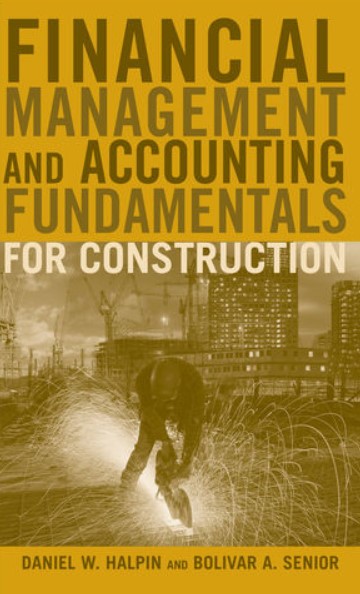If you are looking for a free PDF download of Financial Management and Accounting Fundamentals for Construction PDF then you have landed in the right place. Today in this blog article, we are sharing with our visitors the original ebook using direct links which can be found at the end of this blog post. To ensure user-safety and faster downloads, we have uploaded this .pdf file to our online cloud repository so that you can enjoy a hassle-free downloading experience.
At Blogging Bubble, we believe in genuine quality and fast server speed which are a part of our core philosophy and promise to our visitors. We hope that you people benefit from our website!
Now before that we distribute the free PDF download of Financial Management and Accounting Fundamentals for Construction PDF with you, let’s take a look into few of the important details regarding this ebook.
Here’s the cover image preview of Financial Management and Accounting Fundamentals for Construction PDF:
Contents
Overview
Here’s the complete overview of Financial Management and Accounting Fundamentals for Construction PDF:
This is one of the most demanded and best selling book in the world. It helps students to ace their tough exams and scores high in particular subject. It has some great features shared below. It is also very best for quick review few days before your boards exam.
TECHNOLOGY/ENGINEERING/CIVIL
SUCCESSFUL FINANCIAL MANAGEMENT IN THE CONSTRUCTION INDUSTRY BEGINS WITH THIS HANDS-ON GUIDE
While construction professionals are skilled in the technical side of their work, they often find the financial management aspect of the business daunting. Financial Management and Accounting Fundamentals for Construction will help you better understand and navigate the financial decisions that are part of every construction project.
This book is a compact summary of the basic financial skills that a construction professional must have to be successful in the management of a construction company and its projects. Its topics address many of the questions that any construction administrator will face, such as:
- How to organize and use a company’s financial reports
- What amount of cash must be made available to the contractor to complete a project
- Why the early payment of supplier invoices can enhance profitability
- How to quantify the time value of money in financial decisions
- What tax amount is owed by a company and how it impacts the bottom line
- How to control project costs
- What financial sources are available to a construction contractor for capital expansion
In this text, you will learn about accounting fundamentals, project-related financial matters, and company level financial issues—three factors that are key to your career success. An ideal reference for students of construction management and engineering, as well as professionals who need a quick refresher when dealing with cost control analysis and other financial issues, this text also offers:
- Easy-to-understand coverage of financial concepts specific to the construction industry, including business taxation, project control, engineering economy, and financial forecasting
- Numerous worked examples, plus end-of-chapter review questions and exercises
- Helpful appendices that present the structure of a typical chart of accounts, the flow of transactions through a construction accounting system, and tables required for computing interest and the time value of money
You May Also Need:
Brown’s Boundary Control and Legal Principles 7th Edition PDF Free Download
Occupational Ergonomics: A Practical Approach PDF Free Download
Simplified Engineering for Architects and Builders 12th Edition PDF Free Download
The Gypsum Construction Handbook 7th Edition PDF Free Download
Main Features of Financial Management and Accounting Fundamentals for Construction PDF
Here’s a quick overview of the important features of this book:
TABLE OF CONTENTS
Preface ix
1 INTRODUCTION 1
The Big Paradox 1
What Is Financial Management? 2
First Stop: Financial Accounting 2
Why Construction Accounting Is Different from Accounting in Other Business Sectors 4
Who Is at Risk? 5
Projects: The Output of the Construction Process 6
Project-Level Controls 7
Time Value of Money 8
Entrepreneurial Issues 8
Review Questions and Exercises 9
2 UNDERSTANDING FINANCIAL STATEMENTS 11
Introduction 11
Why Should You Care about Accounting? 12
Generally Accepted Accounting Principles 12
Cash and Accrual Bases: Two Ways to Look at Accounting 13
Cash Basis of Accounting 14
Accrual Basis of Accounting 15
Accounts 16
Account Hierarchy 16
Financial Reports 17
Bookkeeping 19
The Balance Sheet 20
Balance Sheet Layout 21
Balance Sheet Account Categories in Detail 21
The Fundamental Accounting Equation 22
Asset Values 23
The Fundamental Equation and Owners’ Risk 24
Balance Sheet for Fudd Associates, Inc. 24
Key Accounts 26
The Income Statement 29
Components of an Income Statement – More Details 32
The Statement of Cash Flows 35
Contract Backlog 37
Public Corporations 38
Review Questions and Exercises 39
3 ANALYZING COMPANY FINANCIAL DATA 43
Introduction 43
Vertical and Horizontal Analyses 44
Vertical Analysis: Financial Ratios 44
Liquidity Indicators: Can This Company Get Cash in a Hurry? 45
Current Ratio 45
Quick Ratio 46
Working Capital 47
Profitability Indicators: Is This Company Making Enough Profit? 48
Return on Equity 48
Return on Revenue 50
Return on Assets 51
Earnings Per Share 51
Efficiency Indicators: How Long Does It Take a Company to Turn over Its Money? 52
Average Age of Inventory 53
Average Age of Accounts Receivable (Collection Period) 55
Average Age of Accounts Payable 56
Other Average Ages 57
Operating Cycle 57
Turnover Ratios 58
Revenue to Assets Turnover 58
Capital Structure Indicators: How Committed Are the Owners? 59
Debt to Equity 60
Assets to Equity (Leverage) 60
Other Indicators 60
Horizontal Analysis: Tracking Financial Trends 62
Time Series Graphs 62
Index-Number Trend Series 63
Conclusion 63
Review Questions and Exercises 64
4 ACCOUNTING BASICS 71
Introduction 71
Transaction Processing 71
Journalizing the Transaction 73
A Transaction to Enter Initializing Capital 74
A Vendor Billing Transaction 74
A Billing to the Client 76
Posting Entries to the Ledger 78
Relationship of Work-in-Progress and Revenue/Expense Accounts 80
Closing the Accounting Cycle 82
Recognition of Income 83
Percentage-of-Completion Method of Income Recognition 83
Completed-Contract Method of Income Recognition 85
Transactions during a Period 86
Posting to the General Ledger during the Accounting Period 88
Closing Actions at the End of the Period 91
Review Questions and Exercises 93
5 PROJECT-LEVEL COST CONTROL 97
Objectives of Project-Level Cost Control in Construction 97
Unique Aspects of Construction Cost Control 98
Types of Costs 99
The Construction Estimate 99
Cost Control System 101
Building a Cost Control System 101
Cost Accounts 103
Cost Account Structure 104
Project Cost Code Structure 106
Cost Accounts for Integrated Project Management 110
Earned Value Analysis 113
Labor Data Cost Collection 122
Review Questions and Exercises 125
6 FORECASTING FINANCIAL NEEDS 129
Importance of Cash Management 129
Understanding Cash Flow 129
Retainage 131
Project Cost, Value, and Cash Profiles 131
Cash Flow Calculation—A Simple Example 133
Peak Financial Requirements 136
Getting Help from the Owner 137
Optimizing Cash Flow 138
Project Cash Flow Estimates 141
Using Software for Cash Flow Computations 144
Company-Level Cash Flow Planning 145
Strategic Cash Flow Management: “Cash Farming” 145
Project and General Overhead 146
Fixed Overhead 148
Considerations in Establishing Fixed Overhead 149
Breakeven Analysis 151
Basic Relationships Governing the Breakeven Point 154
Review Questions and Exercises 155
7 TIME VALUE OF MONEY AND EVALUATING INVESTMENTS 161
Introduction 161
Time Value of Money 162
Interest 162
Simple and Compound Interest 163
Nominal and Effective Rate 165
Equivalence and MARR 166
Discount Rate 167
Importance of Equivalence 167
Inflation 168
Sunk Costs 169
Cash Flow Diagrams 169
Annuities 171
Conditions for Annuity Calculations 173
Calculating the Future Value of a Series of Payments 174
Summary of Equivalence Formulas 175
Worth Analysis Techniques: An Overview 176
Present Worth Analysis 179
Investments with Different Life Spans 180
Equivalent Annual Worth (EAW) 181
Internal Rate of Return 183
Limitations of the IRR Method 185
An Example Involving Cost Recovery 186
Comparison Using EAW 188
An IRR Example—Owner Financing Using Bonds 191
Review Questions and Exercises 194
8 CONSTRUCTION LOANS AND CREDIT 199
Introduction 199
The Construction Financing Process 200
A Sample Developmental Project 202
The Amount of the Loan 204
How Is the Cap Rate Determined? 205
Mortgage Loan Commitment 206
Construction Loan 206
Commercial Lenders 208
Lines of Credit 209
Interest Paid on Outstanding Balance 210
Commitment Fees 211
Compensating Balances 211
Clean-Up Requirement 212
Collaterals 212
Accounts Receivable Financing 213
Trade Credits 213
Long Term Financing 215
Loans with End-of-Term Balloon Payments 216
Review Questions and Exercises 218
9 THE IMPACT OF TAXES 219
Introduction 219
Types of Taxes 220
Income Tax Systems 221
Alternatives for Company Legal Organization 221
Sole Proprietorships 222
Partnerships 222
Corporations 222
Limited Liability Partnerships and Companies 223
Other Options 224
Taxation of Business 224
Business Deductions in General 227
Taxable Income: Individuals 227
Itemized Deductions, Standard Deductions, and Personal
Exemptions 228
The Tax Significance of Depreciation 229
Calculating Depreciation 230
Straight Line Method 231
The Production Method 232
Depreciation Based on Current Law 233
Marginal Tax Rates 235
Tax Credits 238
Tax Payroll Withholding 239
Tax Payment Schedules 239
Marginal, Average, and Effective Tax Rates 239
Net Operating Losses 240
Taxes on Dividends and Long-Term Capital Gains 242
Alternative Minimum Tax 242
Summary 243
Review Questions and Exercises 243
APPENDIX A TYPICAL CHART OF ACCOUNTS 247
APPENDIX B FURTHER ILLUSTRATIONS OF TRANSACTIONS 251
APPENDIX C COMPOUND INTEREST TABLES 275
References 301
Index 305
Download Financial Management and Accounting Fundamentals for Construction PDF Free
Alright, now in this part of the blog post, you will be able to access the free PDF download of Financial Management and Accounting Fundamentals for Construction PDF using our direct links mentioned at the end of this post. We have uploaded a original genuine PDF ebook of this book to our online file repository so that you can enjoy a blazing-fast and safe downloading.
FILE SIZE: MB
Please guys share this Post with your friends and colleagues to Help Them.








